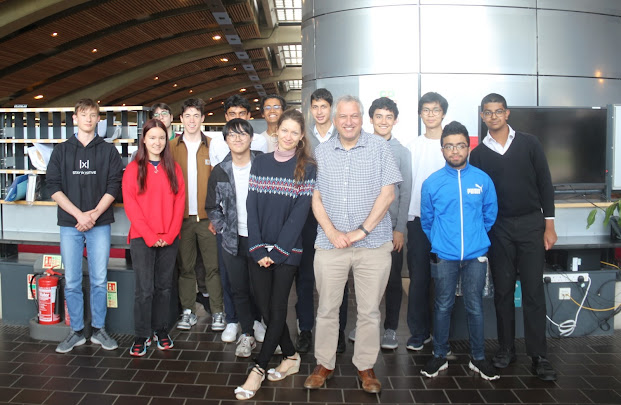On the morning of Wednesday 19th June, a group of pupils and teachers gathered at King’s Cross station for a trip to visit Trinity College in Cambridge.
Mr Morris and Mr Cullen-Hewitt filled the taxi ride with commentaries on several of the more famous landmarks on our route, and provided some insight into their own experiences during their time in Cambridge.
When we arrived at the Centre for Mathematical Sciences, we were greeted by an Old Pauline, Imre Leader, who, since graduation, has done lots of research in Combinatorics and become a professor of Pure Mathematics at Trinity College Cambridge. After leading us through to the centre of the CMS, our first of two Mathematics sessions began. The lecturer began by posing a question on Euclidean Geometry, and, when only one of us was able to solve it, the idea of the Miquel point was introduced and its subsequent generalisation regarding a triangle and a cyclic quadrilateral. We then proved some facts about the Miquel point, which gave us the necessary machinery to solve an IMO Geometry problem within 5 minutes! Returning to the original problem many of us were able to use the newly discovered machinery of the Miquel point to complete the solution.After lunch at Trinity College, the second session was led
by Imre Leader. It was related to planar graphs, a collection of points and
lines connecting those points that can be represented in 2D space with no two
lines intersecting each other, and drawn in such a way that no point is
completely unconnected from the others. The first half of the session was spent
on a problem sheet on graphs, towards the end of which we were given some new
insight into the essence of mathematical induction.
However, it is in fact well known, that no mathematical
proofs (that do not rely on computing technology) exist for the four-colour
theorem, so we know Kempe’s proof must have a flaw somewhere! However, it in
fact took mathematicians 11 years to notice the flaw in his proof - very
tricky, minor, but in fact fatal for his idea.
It was on this bombshell that our trip to Trinity College was forced to end, and we were left to ponder where the mistake in this proof could lie as we made our way to the train station and caught the train back to London still discussing where the error lay in Kempe’s proof.
It was an eventful day, from a small taster of Olympiad level Euclidean Geometry to an insightful session on an introduction to planar graphs and the 4 Colour Theorem, but overall intriguing and absolutely an experience worth repeating.


